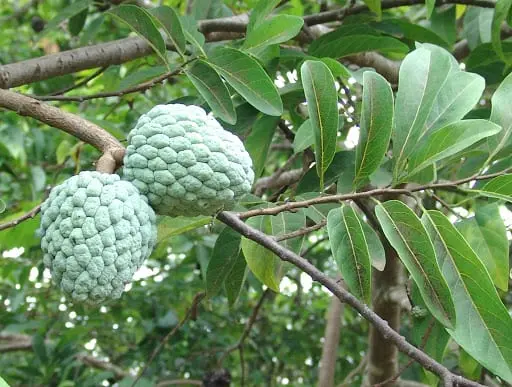Contents
Description
On the shelves of fruit departments in shops of Spain, you can often find a strange fruit or vegetable. It does not look like anything and has a strange name (Cherimoya). What is it?
First of all, this is a fruit, a rather tasty fruit loved by the Spaniards. Cherimoya (lat.Annona cherimola) is the name of a tree that grows in countries with subtropical and temperate climates, in particular in Spain.
The tree is massive – up to 9 meters high, with large wide leaves and beautiful flowers. In one season, about 200 fruits can be harvested from a tree, and believe me, this is not enough.
The fruits of the cherimoia (Hirimoia), what you see on the counter, are cone-shaped with segments. It is difficult to describe, once you see it, you will remember the shape and immediately distinguish this fruit from the rest. Fruits come in different sizes, up to 10 cm in diameter and 20 cm in height. The weight of one fruit varies from 0.5 kg to 3 kg.

You will hardly find the largest options, but 0.5–1 kg is quite enough. The pulp of a ripe fruit is similar in consistency to a cream of white, maybe a little yellowish. And bones, bones are many and they are large enough. One fruit contains 10–20 seeds – this is normal. Remember !!! You cannot eat bones, they are dangerous to health!
Cheremoya is also often called “ice cream tree”. The explanation is simple: the ripe pulp tastes like ice cream. And very often the fruit is eaten this way. It is frozen and then eaten with a spoon or added to cocktails, fruit salads and creamy ice cream.
The taste is very pleasant, slightly sweet and delicate. A bit like an apple, like a sherbet, like a light whipped cream. Gourmets (we believe them, don’t we) say that the taste resembles a mixture of papaya, pineapple, mango and strawberry.
Name history

The tree got its name thanks to the Incas. In translation from their language “cherimoya” means “cold seeds”. This probably came from the fact that cherimoya is a very cold-resistant tree and feels quite well in cold temperatures.
Composition and calorie content of fruits
Oh, this is a very healthy fruit. It is lightweight, non-nutritive, only 74 kcal per 100 g and contains vitamins C, B group, PP, a lot of potassium, calcium, magnesium, sodium, phosphorus, copper, zinc, iron, manganese, folic acid, etc.
Caloric content 75 kcal
Beneficial features

- It is not difficult to guess that if the composition contains such an amount of minerals and vitamins, then the fruit has plenty of useful properties.
- Suitable for those with a sweet tooth who care about their figure.
- It has a beneficial effect on the liver and stomach.
- Possesses bacterial properties.
- From seeds and leaves, solutions are made to combat lice, as well as insect repellents (mosquitoes and others).
- The dried fruits are used as a medicine for food poisoning.
- Laxatives are made from seeds.
- It is believed that the presence of cherimoya in the diet prevents the development of tumors in the body.
Cherimoya harm

Cherimoya contains a large amount of sugar and carbohydrates, so diabetics should use these fruits with caution. This product has no other serious contraindications, only individual intolerance. Those who first decided to try cherimoya should know that there is no way to eat its seeds (seeds inside the fruit) – they are poisonous.
In the homeland of cherimoya, when handled correctly, bones are successfully used as an antiparasitic agent, and they also help with food poisoning. However, those who are not familiar with such original recipes should not experiment.
Although nature has taken care of safety, making cherimoya seeds unusually hard, there are people who want to taste this part of the fruit. Therefore, it is worth remembering that they absolutely cannot be crushed, chewed and consumed. In addition, it is worth knowing that due to eye contact with cherimoya seeds juice, a person may even go blind.
How to eat cherimoya fruits
Most often they are eaten raw, or frozen and eaten “sherbet”. But you can also cook. Most often, you can find cherimoya in pastries and dessert dishes. You yourself can add it to yoghurts, fruit salads, make cocktails. As it is – cut into two halves and spoon out the pulp. You can’t eat seeds !!!









